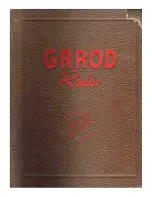
7
TK-390
4. Group Features
You can use these features using the programming soft-
ware (KPG-38D).
4-1. “TOT” (Time-Out Timer)
The transceiver has the “TOT”. This parameter selects
the period of time users can continuously transmit.
When the selected period passes, the transceiver gener-
ates an warning tone and stops the transmission.
4-2. “TOT” Pre-Alert
The transceiver has “TOT” pre-alert timer. This param-
eter selects the time at which the transceiver generates
“TOT” pre-alert tone before “TOT” is expired.
“TOT” will be expired when the selected time passes
from a TOT pre-alert tone.
4-3. “TOT” Re-Key Time
The transceiver has “TOT” re-key timer. This timer is the
time you can not transmit after “TOT” exceeded. After
“TOT” re-key time expired you can transmit again.
4-4. “TOT” Reset Time
The transceiver has “TOT” reset timer. This timer is the
minimum wait time allowed during a transmission that will
reset the “TOT” count.
“TOT” reset time causes the “TOT” to continue even
after PTT is released unless the “TOT” reset timer has ex-
pired.
4-5. Group Delete/Add
The transceiver can set the delete/add in each group. If
“Delete” is selected, the transceiver does not scan the de-
leted group in multi group scan.
4-6. Battery Save
This is the automatic battery saver during a standby
mode operation. The receiver circuit is repeated on and off
to conserve the battery life.
4-7. Signalling
Signalling “AND/OR” sets the audio unmute condition
for any channel programmed with the option signalling (2-
Tone/DTMF).
AND : “AND” requires both the valid option signalling
and the programmed QT/DQT to be received for audio to
unmute (and initiate an option signalling decode alert).
OR : “OR” requires either the valid option signalling or
the programmed QT/DQT to be received for audio to
unmute (an option signalling decode alert is only initiated
if the proper option signalling is decoded).
OPERATING FEATURES
5. Channel Features
You can use these features using the programming soft-
ware (KPG-38D).
5-1. Option Signalling
The transceiver is programmable to the option signalling
(2-Tone decode program 1, 2-Tone decode program 2, 2-
Tone decode program 3, DTMF decode) to each channel. It
is useful to receive an individual call.
Receive format is selectable “AND” or “OR” with QT/
DQT for each group. The radio response of option signalling
is programmable “(Call) Alert tone” or “Transpond” for each
option signalling (2-Tone decode program 1, 2-Tone decode
program 2, 2-Tone decode program 3, DTMF).
5-2. PTT ID
PTT ID provides a DTMF ANI, MSK ANI or ANI board ID (if
installed) to be sent with every time PTT (connect ID at be-
ginning of transmission, disconnect ID at end of transmis-
sion, or both).
You can program PTT ID “on” or “off” for each channel.
The contents of ID are programmed for each transceiver.
5-3. Busy Channel Lockout
Transmission is inhibited when the channel is busy. It is
able to set this feature “Yes” or “No” for each channel.
5-4. Beat Shift
This is the feature that the microprocessor shifts its sys-
tem clock frequency slightly to prevent the receive interfer-
ence. This transceiver can program this feature “Yes” or
“No” for each channel.
5-5. TX Power
You can set the transmission power “High” or “Low” for
each channel. The each power setting is tuned at factory.
However, you can re-tune the power, using PC Tuning
Mode of KPG-38D.
5-6. Wide/Narrow
You can set the occupied band width mode “Wide” or
“Narrow” for each channel. It is useful for the operator to
use the transceiver on various sites.
5-7. Scan Delete/Add
Scanning “delete/add” is programmable for each chan-
nel. Set the currently selected channel required to include in
the scan sequence to “add”.
The operator can change the “delete/add” information
using the key programmed to “delete/add” function.
5-8. Compander
This function reduces the noise on the communications
channel used by the transceiver and improves reception.
If Wide/Narrow function is set to wide, this function
doesn't perform.








































